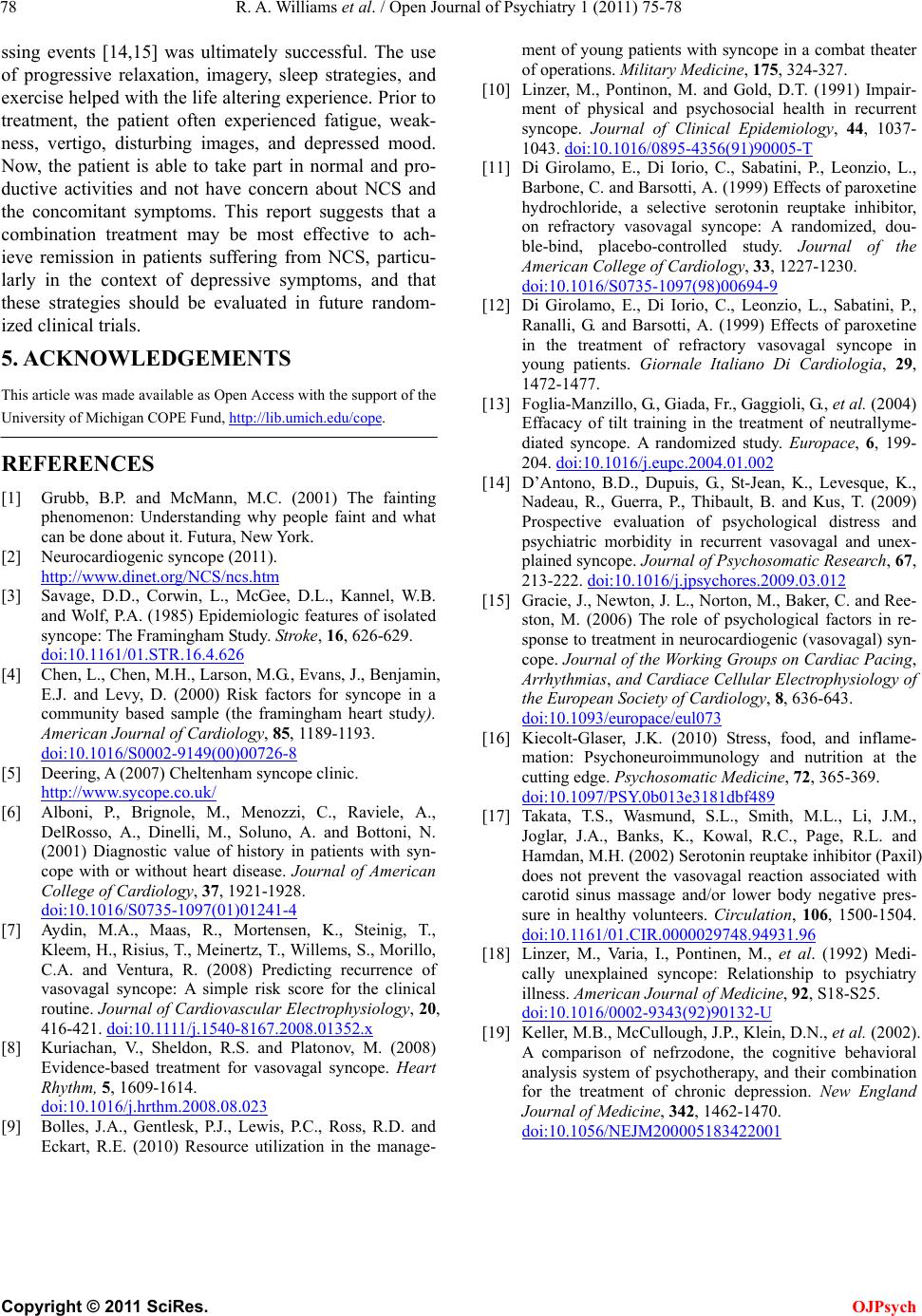
R. A. W illiams et al. / Open Journal of Psychiatry 1 (2011) 75-78
Copyright © 2011 SciRes. OJPsych
78
ssing events [14,15] was ultimately successful. The use
of progressive relaxation, imagery, sleep strategies, and
exercise helped with the life altering experience. Prior to
treatment, the patient often experienced fatigue, weak-
ness, vertigo, disturbing images, and depressed mood.
Now, the patient is able to take part in normal and pro-
ductive activities and not have concern about NCS and
the concomitant symptoms. This report suggests that a
combination treatment may be most effective to ach-
ieve remission in patients suffering from NCS, particu-
larly in the context of depressive symptoms, and that
these strategies should be evaluated in future random-
ized clinical trials.
5. ACKNOWLEDGEMENTS
This article was made available as Open Access with the support of the
University of Michigan COPE Fund, http://lib.umich.edu/cope.
REFERENCES
[1] Grubb, B.P. and McMann, M.C. (2001) The fainting
phenomenon: Understanding why people faint and what
can be done about it. Futura, New York.
[2] Neurocardiogenic syncope (2011).
http://www.dinet.org/NCS/ncs.htm
[3] Savage, D.D., Corwin, L., McGee, D.L., Kannel, W.B.
and Wolf, P.A. (1985) Epidemiologic features of isolated
syncope: The Framingham Study. Stro ke, 16, 626-629.
doi:10.1161/01.STR.16.4.626
[4] Chen, L., Chen, M.H., Larson, M.G., Evans, J., Benjamin,
E.J. and Levy, D. (2000) Risk factors for syncope in a
community based sample (the framingham heart study).
American Journal of Cardiology, 85, 1189-1193.
doi:10.1016/S0002-9149(00)00726-8
[5] Deering, A (2007) Cheltenham syncope clinic.
http://www.sycope.co.uk/
[6] Alboni, P., Brignole, M., Menozzi, C., Raviele, A.,
DelRosso, A., Dinelli, M., Soluno, A. and Bottoni, N.
(2001) Diagnostic value of history in patients with syn-
cope with or without heart disease. Journal of American
College of Cardiology, 37, 1921-1928.
doi:10.1016/S0735-1097(01)01241-4
[7] Aydin, M.A., Maas, R., Mortensen, K., Steinig, T.,
Kleem, H., Risius, T., Meinertz, T., Willems, S., Morillo,
C.A. and Ventura, R. (2008) Predicting recurrence of
vasovagal syncope: A simple risk score for the clinical
routine. Journal of Cardiovascular Electrophysiology, 20,
416-421. d oi:10. 1111/j.1540-8167.2008.01352.x
[8] Kuriachan, V., Sheldon, R.S. and Platonov, M. (2008)
Evidence-based treatment for vasovagal syncope. Heart
Rhythm, 5, 1609-1614.
doi:10.1016/j.hrthm.2008.08.023
[9] Bolles, J.A., Gentlesk, P.J., Lewis, P.C., Ross, R.D. and
Eckart, R.E. (2010) Resource utilization in the manage-
ment of young patients with syncope in a combat theater
of operations. Military Medicine, 175, 324-327.
[10] Linzer, M., Pontinon, M. and Gold, D.T. (1991) Impair-
ment of physical and psychosocial health in recurrent
syncope. Journal of Clinical Epidemiology, 44, 1037-
1043. doi:10.1016/0895-4356(91)90005-T
[11] Di Girolamo, E., Di Iorio, C., Sabatini, P., Leonzio, L.,
Barbone, C. and Barsotti, A. (1999) Effects of paroxetine
hydrochloride, a selective serotonin reuptake inhibitor,
on refractory vasovagal syncope: A randomized, dou-
ble-bind, placebo-controlled study. Journal of the
American College of Cardiology, 33, 1227-1230.
doi:10.1016/S0735-1097(98)00694-9
[12] Di Girolamo, E., Di Iorio, C., Leonzio, L., Sabatini, P.,
Ranalli, G. and Barsotti, A. (1999) Effects of paroxetine
in the treatment of refractory vasovagal syncope in
young patients. Giornale Italiano Di Cardiologia, 29,
1472-1477.
[13] Foglia-Manzillo, G., Giada, Fr., Gaggioli, G., et al. (2004)
Effacacy of tilt training in the treatment of neutrallyme-
diated syncope. A randomized study. Europace, 6, 199-
204. doi:10.1016/j.eupc.2004.01.002
[14] D’Antono, B.D., Dupuis, G., St-Jean, K., Levesque, K.,
Nadeau, R., Guerra, P., Thibault, B. and Kus, T. (2009)
Prospective evaluation of psychological distress and
psychiatric morbidity in recurrent vasovagal and unex-
plained syncope. Journal of Psychosomatic Research, 67,
213-222. doi:10.1016/j.jpsychores.2009.03.012
[15] Gracie, J., Newton, J. L., Norton, M., Baker, C. and Ree-
ston, M. (2006) The role of psychological factors in re-
sponse to treatment in neurocardiogenic (vasovagal) syn-
cope. Journal of the Working Groups on Cardiac Pacing,
Arrhythmias, and Cardiace Cellular Electrophysiology of
the European Society of Cardiology, 8, 636-643.
doi:10.1093/europace/eul073
[16] Kiecolt-Glaser, J.K. (2010) Stress, food, and inflame-
mation: Psychoneuroimmunology and nutrition at the
cutting edge. Psychosomatic Medicine, 72, 365-369.
doi:10.1097/PSY.0b013e3181dbf489
[17] Takata, T.S., Wasmund, S.L., Smith, M.L., Li, J.M.,
Joglar, J.A., Banks, K., Kowal, R.C., Page, R.L. and
Hamdan, M.H. (2002) Serotonin reuptake inhibitor (Paxil)
does not prevent the vasovagal reaction associated with
carotid sinus massage and/or lower body negative pres-
sure in healthy volunteers. Circulation, 106, 1500-1504.
doi:10.1161/01.CIR.0000029748.94931.96
[18] Linzer, M., Varia, I., Pontinen, M., et al. (1992) Medi-
cally unexplained syncope: Relationship to psychiatry
illness. American Journal of Medicine, 92, S18-S25.
doi:10.1016/0002-9343(92)90132-U
[19] Keller, M.B., McCullough, J.P., Klein, D.N., et al. (2002).
A comparison of nefrzodone, the cognitive behavioral
analysis system of psychotherapy, and their combination
for the treatment of chronic depression. New England
Journal of Medicine, 342, 1462-1470.
doi:10.1056/NEJM200005183422001